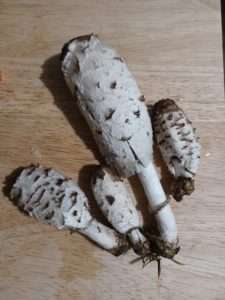It ain’t over ’til it’s over, folks. While the peak of fall mushroom season has passed, there are still tasty edible fungi to be found out there (along with edible wild plants, for that matter!) You might not find the big flushes of mushrooms you did back in October, but then again–you might get lucky in that regard. Late fall mushroom hunting doesn’t need to be wasted time.
Why Go Out Now?
First, it’s a good opportunity to get out and explore new places while the weather still allows. You may have to look harder to find anything, but keen eyes can still find the prize. So what if you only found three little chanterelles after a few hours of walking? You’ve discovered a new place to look for them when next year’s season starts!
 Now’s also a great time to go back and check your favorite fall mushroom hunting spots. Many fungal colonies will fruit multiple times in a season. For example, I was pretty sure that the shaggy manes (Coprinus comatus) that grew like gangbusters in October and early November were done for the year. However, yesterday morning I took a peek at my favorite spot, and was pleased to see about a dozen of them poking up out of the ground. Only four were big enough to pick, including that big one in the middle that was over seven inches tall, but I’ll be keeping an eye on the rest over the next few days. And I’ll also be taking a walk through a few of my other familiar stomping grounds, just in case.
Now’s also a great time to go back and check your favorite fall mushroom hunting spots. Many fungal colonies will fruit multiple times in a season. For example, I was pretty sure that the shaggy manes (Coprinus comatus) that grew like gangbusters in October and early November were done for the year. However, yesterday morning I took a peek at my favorite spot, and was pleased to see about a dozen of them poking up out of the ground. Only four were big enough to pick, including that big one in the middle that was over seven inches tall, but I’ll be keeping an eye on the rest over the next few days. And I’ll also be taking a walk through a few of my other familiar stomping grounds, just in case.
Fall Mushroom Hunting Turns Toward Winter
If you’re in a region that’s already had a hard freeze a lot of the fungi may be done fruiting for the year, as the fungi are protecting their mycelium from cold damage. However, some species of mushroom, like yellowfoot (Craterellus tubaeformis) and hedgehog (Hydnum repandum) are more than happy to fruit in late fall and winter. These cold-hardy fungi may not always produce large flushes, but they’re still worth looking for.
Keep in mind that you may have to work harder to find anything, especially if there’s snow and ice on the ground. It’s not just due to visibility, but also increased difficulty in moving around. Make sure you dress for the weather, take a thermos of nice hot soup with you, and see if any of your favorite fall mushroom hunting spots have any winter surprises for you!
Making Do With Less
While it’s fun to bring home several pounds of morels or chanterelles or another single species, sometimes you may only have a handful of a few different mixed species. Or you might be like me last week, and carry home exactly six saffron milkcaps (Lactarius deliciosus), two of which ended up being too old and buggy to eat. (Thankfully the one really big one was still good!)
 This is where you can experiment with recipes that allow you to combine species. I took those milkcaps and combined with with some criminis (Agaricus bisporis) from the store so that I had about an equal amount of each. I sliced them up, and put them into this mushroom gravy recipe, then served it over roasted mashed potatoes. Absolutely lovely, and the crunchiness of the milkcaps added a nice textural note. And it would have worked just as well if I’d had a mix of other wild mushrooms like late chanterelles (Cantharellus spp.)
This is where you can experiment with recipes that allow you to combine species. I took those milkcaps and combined with with some criminis (Agaricus bisporis) from the store so that I had about an equal amount of each. I sliced them up, and put them into this mushroom gravy recipe, then served it over roasted mashed potatoes. Absolutely lovely, and the crunchiness of the milkcaps added a nice textural note. And it would have worked just as well if I’d had a mix of other wild mushrooms like late chanterelles (Cantharellus spp.)
You don’t have to limit your foraging to the warmer times of the year. Any time is a great opportunity to go out and look for edible wild foods–and if you’re like me, you’ll take any excuse to get outside!
